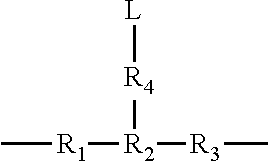Nucleotide analogs
a technology of nucleotide analogs and analogs, applied in the field of nucleotide analogs, can solve the problem of difficult to resolve the number of nucleotides in a homopolymer, and achieve the effect of good incorporation of a single nucleotid
- Summary
- Abstract
- Description
- Claims
- Application Information
AI Technical Summary
Benefits of technology
Problems solved by technology
Method used
Image
Examples
example 1
Caproic-Glu and Caproic-Glu
[0085]
3-tert-Butyldisulfanyl-2-(9H-fluoren-9-ylmethoxycarbonylamino)-propionic acid 2,5-dioxo-pyrrolidin-1-yl ester (2)
[0086]
[0087]To a solution of Fmoc-Cys(SStBu)-OH (1, 2.15 g, 5.0 mmole,) dissolved in anhydrous CH2Cl2(30 mL) was added N-Ethyl-N′-(3-dimethylaminopropyl)carbodiimide hydrochloride (EDAC, 1.146 g, 6 mmole), the reaction mixture was stirred for 10 min. at room temperature (RT) and then added N-hydroxysuccinimide (NHS) (0.690 g, 6.0 mmole). To this reaction mixture was added catalytic amount of N,N′-dimethlyaminopyridine and stirred at RT until completion of reaction tested with TLC. The solvent was evaporated and the residue obtained was extracted with ethyl acetate (50 mL×2), washed with 1M NaHCO3 (10 mL), followed by brine solution (20 mL) and dried over anhydrous Na2SO4. Evaporation of the solvent afforded 2 as a white crystalline solid. Yield. 2.5 g (95%).
6-[3-tert-Butyldisulfanyl-2-(9H-fluoren-9-ylmethoxycarbonylamino)-propionylamino]-h...
example 2
Caproic-Asp-Asp
[0110]
C* cap-Asp-Asp:
[0111]α-N-Fmoc-S-tert-butylthio-L-cysteine (1 g, 2.32 mmol) was dissolved in anhydrous acetonitrile and solution of dicyclohexylcarbodiimide (DCC) (573 mg, 2.78 mmol in CH3CN) was added followed by solution of NHS (345 mg, 3.01 mmol in CH3CN). After 1 hr. dicyclohexylurea was spun down and active ester used without purification in coupling with ε-amino-hexanoic acid (304 mg, 2.32 mmol) dissolved in 50% aq. DMF. N,N′-Diisopropylethylamine (DIPEA) was added to correct pH to 8.0. Upon completion reaction mixture was acidified to pH 3 and partitioned between water and dichloromethane (DCM). Organic layer was dried over anhydrous Na2SO4 and evaporated to give 1.33 g of crude material. Purification using flash chromatography in DCM / methanol gave 745 mg of pure material (MW=544.75).
[0112]α-N-Fmoc-S-tert-butylthio-L-cyst-caproic acid (3, 77 mg, 141 μmols, CH3CN) was converted to NHS active ester using DCC (35 mg, 169 μmols, CH3CN) and NHS (21 mg, 183 μmol...
example 3
Caproic-Arg-Arg-Arg
[0119]
Compound 32
[0120]Compound 31 (100 mg, 0.18 mmol) was dissolved in 0.8 ml DMF and added 0.2 mL piperidine and then kept at RT for 30 min. DMF was removed and the residue was purified with flash column using CH2Cl2: CH3OH (2:1). The purified amine (35 mg) was dissolved in 1 mL DMF and used directly for the next step without characterization. 3.5 mg of the purified amine in 0.1 mL DMF (10.8 μmol) was added 60 μL DMF and 40 μL DIPEA and then Cy5 Mono NHS Ester (6.63 μmol) in 100 μL anhydrous DMF was added into the solution. After 30 minutes, the reaction mixture was purified with HPLC (Waters Delta 600 pump and 2487 Dual λ Absorbance Detector, Phenomenex C18 preparative column, 250×21.00 mm 10 micron, gradient: 100% A for 5 min, then 1% B / min, buffer A 0.05 M TEAB, buffer B CH3CN, 10 mL / min flow). Fractions containing the desired compound 32 were pooled and quantified; (3.0 μmol, 45%, ε649=250000); ESI-MS (negative ion mode): m / z=959.20 (M-H).
Compound 33
[0121]Th...
PUM
 Login to View More
Login to View More Abstract
Description
Claims
Application Information
 Login to View More
Login to View More - R&D
- Intellectual Property
- Life Sciences
- Materials
- Tech Scout
- Unparalleled Data Quality
- Higher Quality Content
- 60% Fewer Hallucinations
Browse by: Latest US Patents, China's latest patents, Technical Efficacy Thesaurus, Application Domain, Technology Topic, Popular Technical Reports.
© 2025 PatSnap. All rights reserved.Legal|Privacy policy|Modern Slavery Act Transparency Statement|Sitemap|About US| Contact US: help@patsnap.com



